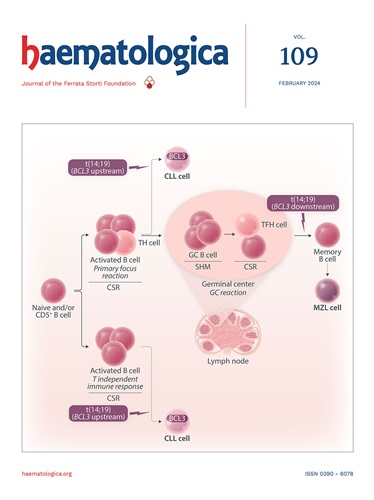Asciminib for Philadelphia chromosome positive leukemias.
IF 8.2
1区 医学
Q1 HEMATOLOGY
引用次数: 0
Abstract
Twenty-five years after the introduction of imatinib, we have entered a new era of therapy for Chronic Myeloid Leukemia (CML). Despite the development of second and third generation (2G and 3G) tyrosine kinase inhibitors (TKIs), their impact have been incremental in improving outcomes for CML patients. While frontline use of 2G TKIs have improved molecular response rates and reduced progression to blast phase, there has been no improvement in overall survival compared to imatinib, likely due to the higher toxicity and consequent higher non CML-related mortality. Imatinib remains the most prescribed therapy for CML worldwide, despite it being the least potent TKI and most prone to resistance and progression. Asciminib, the first STAMP (Specifically Targeting the ABL Myristoyl Pocket) inhibitor, binds to the myristoyl pocket of BCR::ABL1. Its specificity minimises off-target toxicity which enables asciminib to finally break this frustrating link between potency and toxicity. After a decade of clinical trials, both in patients with resistance and intolerance to two or more TKIs, and more recently in the frontline setting, asciminib is fulfilling its early promise of a more rapid and reliable pathway to long-term disease control with minimal toxicity. There are however some unexpected challenges when using asciminib that require further investigation. In this Spotlight we review the key studies and outline the potential impact and current limitations of this first STAMP inhibitor in the CML setting and in other leukemias where ABL1 or ABL2 is the key target.阿西米尼治疗费城染色体阳性白血病。
引入伊马替尼25年后,我们进入了慢性髓性白血病(CML)治疗的新时代。尽管开发了第二代和第三代(2G和3G)酪氨酸激酶抑制剂(TKIs),但它们在改善CML患者预后方面的影响一直在增加。虽然一线使用2G TKIs提高了分子反应率,减少了向爆炸期的进展,但与伊马替尼相比,总生存期没有改善,可能是由于更高的毒性和随之而来的更高的非cml相关死亡率。伊马替尼仍然是全球最常用的CML治疗药物,尽管它是最不有效的TKI,最容易产生耐药性和进展。Asciminib是首个STAMP (specific Targeting the ABL Myristoyl Pocket)抑制剂,与BCR::ABL1的肉豆蔻酰基口袋结合。它的特异性最大限度地减少了脱靶毒性,使阿西米尼最终打破了效力和毒性之间令人沮丧的联系。经过十年的临床试验,包括对两种或两种以上tki的耐药和不耐受患者,以及最近在一线环境中,阿西米尼正在实现其早期承诺的更快速、更可靠的途径,以最小的毒性实现长期疾病控制。然而,在使用阿西米尼时存在一些意想不到的挑战,需要进一步研究。在这篇聚焦文章中,我们回顾了关键研究,概述了首个STAMP抑制剂在CML和其他以ABL1或ABL2为关键靶点的白血病中的潜在影响和目前的局限性。
本文章由计算机程序翻译,如有差异,请以英文原文为准。
求助全文
约1分钟内获得全文
求助全文
来源期刊

Haematologica
医学-血液学
CiteScore
14.10
自引率
2.00%
发文量
349
审稿时长
3-6 weeks
期刊介绍:
Haematologica is a journal that publishes articles within the broad field of hematology. It reports on novel findings in basic, clinical, and translational research.
Scope:
The scope of the journal includes reporting novel research results that:
Have a significant impact on understanding normal hematology or the development of hematological diseases.
Are likely to bring important changes to the diagnosis or treatment of hematological diseases.
 求助内容:
求助内容: 应助结果提醒方式:
应助结果提醒方式:


